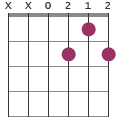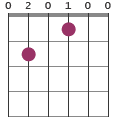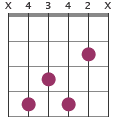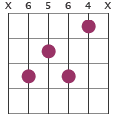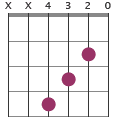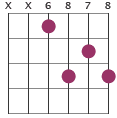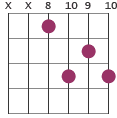7th chords
The 7th chord (also known as dominant 7th) adds another tone to the major triad chord. As the name implies, the added tone is seven steps from the root (following the scale). This chord category is especially common in blues.
Dominant 7 chords
Dominant 7 chords with sharp or flat root
C#7 / Db7
D#7 / Eb7
F#7 / Gb7
G#7 / Ab7
A#7 / Bb7
Comments
The chord names are on top of the pictures. The x letters and numbers indicate that the string shouldn't be played or on which frets. This chord category is not to be confused with the major 7th and minor 7th.
Theory
The dominant seventh doesn't fully correspond to the major key, as the 7th note corresponds to the minor scale. This results in a slight dissonant sounding chord. For example C7 includes the notes C, E, G, Bb while the C major scale includes the notes C, D, E, F, G, A, B and C minor scale C, D, Eb, F, G, Ab, Bb.
The dominant 7th chord can be found on the fifth degree in the major scale. In C major, this would be G7. That is the reason that G7 is common in progression based on the C major key while F7 is not. The table below shows how C major can be harmonized into four-note chords with the dominant 7th appearing as the V chord:
| I | ii | iii | IV | V | iv | iiv |
|---|---|---|---|---|---|---|
| Cmaj7 | Dm7 | Em7 | Fmaj7 | G7 | Am | Bm7b5 |
In chord progressions, the V chord often functions as the second last chord, being unstable and resolving to the “home chord” (I), as in the following progression: C - Am - G7 - C.
Chord structure
The dominant seventh is built with the formula 1-3-5-b7 (root, major 3rd, perfect 5th and minor 7th).
Chord construction
C7 x - C - E - Bb - C - EC#7 x - C# - F - B - C# - x
D7 x - x - D - A - C - F#
D#7 x - D# - G - C# - D - x
E7 E - B - D - G# - B - E
F7 F - C - Eb - A - C - F
F#7 x - x - F# - A# - C# - E
G7 G - B - D - G - B - F
G#7 x - x - G# - D# - F# - C
A7 x - A - E - G - C# - E
A#7 x - x - A# - F - G# - D
B7 x - B - D# - A - B - F#
Guitar versions of the chord
Notes in chord
C7 C - E - G - BbC sharp 7 C# - F - G# - B
D7 D - F# - A - C
D sharp 7 D# - G - A# - C#
E7 E - G# - B - D
F7 F - A - C - Eb
F sharp 7 F# - A# - C# - E
G7 G - B - D - F
G sharp 7 G# - C - D# - F#
A7 A - C# - E - G
A sharp 7 A# - D - F - G#
B7 B - D# - F# - A
The intervals are 1 – 3 – 5 – b7
Progressions
Suggestions of chord sequences that include dominant sevenths:
C - E7 - Am
D - F#7 - G
A chord that resolves into the tonic
In chord progressions, the dominant seventh chord is often used just before the last chord, the tonic. This is because the seventh chord resolves well into the tonic. Some examples:
A7 - D
D7 - G
C7 - F
A few examples with full sequences (including one with D7sus4), using the seventh as a resolving chord, could be as follows:
D - Bm - G - A7 - D
G - Em - C - D7 - G
G - D/F# - Em - C - D7sus4 - D7 - G
And in a minor key:
Em - G - D - Am - B7 - Em
From major to dominant
A common method, especially in styles such as country, is to go from major to dominant with the same root:
C - C7, D - D7, E - E7 and so on.
A few examples of progressions using this idea:
A - D - D7 - G
D - G - G7 - D
E - A - A7 - C
See also: Circle of fifths chord progressions.
Barre chord shapes
The seventh chord is often played as a barre chord. The main movable shapes for dominant 7th barre chords in pictures:
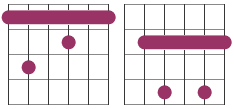
The diagram to the left depicts an E7-shape barre chord for dominant 7th and the diagram to the right depicts
an A7-shape barre chord (the lowest string should not be played). You should test that all strings rings clearly. Especially the fourth string in the E7-shape barre chord can be quite problematic.
Movable shape with root on sixth string
Pictured below is an alternative way to play the dominant seventh chord. The shape is movable with the root note on the lowest string. One way to play is by using the thumb on the lowest string and when pluck the rest of the string with the fingers. Bass walks are of course possible and are useful in jazz.
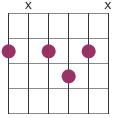
Movable shape with root on fifth string
This is a way to play the dominant seventh chord with a movable shape and this time with the root note on the A-string.
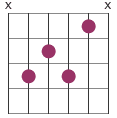
Movable shapes with root on fourth string
And lastly, two movable alternatives. The first with the root on the D-string (the fourth).
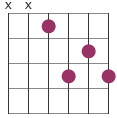
Movable shapes without the root as bass note
This is also a popular choice, but remember that this is an inversion. The root note is on the G-string (third string).
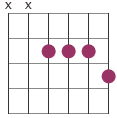
Aside from this, there are more inversions that can be important to know about. These are some examples:
C7: XX2313
D7: XX4535
The root is on the 2nd string.
Voicings
Examples of dominant 7th voicings:
G7: 3X300X
This voicing can be combined with G7sus4 (3X301X) as well as C7sus4 (8X806X) plus C7(b5) (8X807X) and D7sus4 (10 X 10 0 8 X) plus Dm7(11,b5) (10 X 10 0 9 X).
7th chord in open position
Here are additional shapes in open position for this chord category:
C#7/Db7: X4310X
7th chord alterations
Alterations means that a note in the chord is altered, for example, a flattened fifth. Here are some examples, using C as root tone (the shapes are movable).
C7#5: X3X354
C7b5: X3435X
C7#9: X3234X
C7b9: X3232X
We can compare these alterations with the standard dominant seventh:
Chord construction
C7 x - C - E - Bb - C - EC7#5 x - C - x - Bb - E - G#
C7b5 x - C - Gb - Bb - E - x
C7#9 x - C - E - Bb - D# - x
C7b9 x - C - E - Bb - Db - x
Guitar versions of the chord
Notes in chord
C7 C - E - G - BbC7#5 C - E - G# - Bb
C7b5 C - E - Gb - Bb
C7#9 C - E - G - Bb - D#
C7b9 C - E - G - Bb - Db
Theoretical order of notes
In C7#5 (C7+5) and C7b5 (C7-5) the fifth are raised or flattened. And in C7#9 (C7+9) and C7b9 (C7-9) a sharp or a flat ninth are added. See the presentation of altered chords.
Back to chord types

